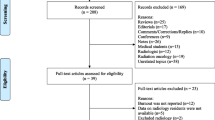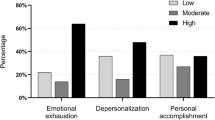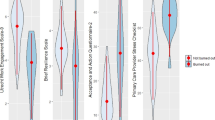Abstract
Physician burnout—a constellation of depersonalization, emotional exhaustion, reduced feelings of personal attachment, and a low sense of accomplishment—is a term that has been around since the 1980s. Burnout rates among residents and fellows are higher than medical students, attending physicians, and age-matched college graduates, with rates ranging from 40–80% of trainees across subspecialties. Unfortunately, burnout among residents and trainees has been linked to lower scores on in-service examinations for internal medicine residents as well as poorer overall health and exercise habits. The purpose of this review is to quantify the extent of burnout among urology residents and examine effective techniques and measures to prevent burnout and practically what can be done to combat this growing epidemic.
Similar content being viewed by others
References
Papers of particular interest, published recently, have been highlighted as: • Of importance •• Of major importance
Maslach C, Jackson SE, Leiter MP, Schaufeli WB, Maslach SRL. Burnout inventory. Palo Alto, CA: Consulting Psychologists Press; 1986.
Tawfik DS, Profit J, Morgenthaler TI, Satele DV, Sinsky CA, Dyrbye LN, et al. Physician burnout, wellbeing, and work unit safety grades in relationship to reported medical errors. Mayo Clin Proc. 2018;93:1571–80.
Shanafelt TD, Balch CM, Bechamps G, Russell T, Dyrbye L, Satele D, et al. Burnout and medical errors among American surgeons. Ann Surg. 2010;251:995–1000.
Wurm W, Vogel K, Holl A, Ebner C, Bayer D, Mörkl S, et al. Depression-burnout overlap in physicians. PLoS One. 2016;11:e0149913.
•• Panagioti M, Geraghty K, Johnson J, et al. Association between physician burnout and patient safety, professionalism, and patient satisfaction: a systematic review and meta-analysis. JAMA Intern Med. 2018;178:1317–30 Well done review of the literature as burnout relates to errors, professionalism and patient satisfaction.
Campbell J, Prochazka AV, Yamashita T, Gopal R. Predictors of persistent burnout in internal medicine residents: a prospective cohort study. Acad Med. 2010;85(10):1630–4.
Shanafelt TD, Bradley KA, Wipf JE, Back AL. Burnout and self-reported patient care in an internal medicine residency program. Ann Intern Med. 2002;136(5):358–67.
Shanafelt TD, Boone S, Tan L, Dyrbye LN, Sotile W, Satele D, et al. Burnout and satisfaction with work-life balance among US physicians relative to the general US population. Arch Intern Med. 2012;172(18):1377–85.
Dyrbye LN, West CP, Satele D, Boone S, Tan L, Sloan J, et al. Burnout among US medical students, residents, and early career physicians relative to the general US population. Acad Med. 2014;89(3):443–51.
West CP, Shanafelt TD, Kolars JC. Quality of life, burnout, educational debt, and medical knowledge among internal medicine residents. JAMA. 2011;306(9):952–60.
Hull SK, DiLalla LF, Dorsey JK. Prevalence of health-related behaviors among physicians and medical trainees. Acad Psychiatry. 2008;32(1):31–8.
Shanafelt TD, Hasan O, Dyrbye LN, Sinsky C, Satele D, Sloan J, et al. Changes in burnout and satisfaction with work-life balance in physicians and the general US working population between 2011 and 2014. Mayo Clin Proc. 2015;90:1600–13.
•• North AC, McKenna PH, Sener A, et al. Burnout in urology-findings from the 2016 AUA Annual Census. Urol Pract. 2018;5:489–94 Important data on burnout from a large 2016 survey.
• Dyrbye LN, Burke SE, Hardeman RR, Herrin J, Wittlin NM, Yeazel M, et al. Association of clinical specialty with symptoms of burnout and career choice regret among US resident physicians. JAMA. 2018;320:1114–30 Interesting analysis of burnout symptoms by specialty.
•• Marchalik Daniel, Goldman Charlotte C., Carvalho Filipe F. L. et al. Resident burnout in USA and European urology residents: an international concern. BJU Int 2019 (1-8). Important data regarding both US and European residents in Urology. Very interesting.
•• Daniel Marchalik MD, MA, Jacob Brems MD, Ariel Rodriguez MS,John H. Lynch MD, Jamie Padmore DM, Lambros Stamatakis MD, Ross Krasnow MD, MPH, The impact of institutional factors on physician burnout: a national study of urology trainees. Urology (2019). Increasingly recognized are institutional factors that affect burnout rates. This paper dives into the details of this issue.
Laskowski ER, Lexell J. Exercise and sports for health promotion, disease, and disability. PM R. 2012;4(11):795–6.
Weight CJ, Sellon JL, Lessard-Anderson CR, Shanafelt TD, Olsen KD, Laskowski ER. Physical activity, quality of life, and burnout among physician trainees: the effect of a team-based, incentivized exercise program. Mayo Clin Proc. 2013;88(12):1435–42.
•• Busireddy Kiran R, Ren Vicky, Miller Jonathan A, et al. Efficacy of interventions to reduce resident physician burnout: a systematic review. Journal of Graduate Medical Education, June 2017 (294-301). One of the most important analyses on burnout interventions and efficacy. Fantastic table displaying the interventions and outcomes.
Bragard I, Etienne AM, Merckaert I, Libert Y, Razavi D. Efficacy of a communication and stress management training on medical residents’ self-efficacy, stress to communicate, and burnout: a randomized controlled study. J Health Psychol. 2010;15(7):1075–81.
Milstein JM, Raingruber BJ, Bennett SH, et al. Burnout assessment in house officers: evaluation of an intervention to reduce stress. Med Teach. 2009;31(4):375–8.
Ospina-Kammerer V, Figley CR. An evaluation of the Respiratory One Method (ROM) in reducing emotional exhaustion among family physician residents. Int J Emerg Ment Health. 2003;5(1):29–32.
McCue JD, Sachs CL. A stress management workshop improves residents’ coping skills. Arch Intern Med. 1991;151(11):2273–7.
•• Daniel M, Goldman CC, Carvalho Filipe FL, et al. Resident burnout in USA and European urology residents: an international concern. BJU Int. 2019(1–8). Recent survey of resident burnout in urology demonstrates it is an international concern.
Bar-Sela G, Lulav-Grinwald D, Mitnik I. “Balint group” meetings for oncology residents as a tool to improve therapeutic communication skills and reduce burnout level. J Cancer Educ. 2012;27(4):786–9.
Barrack RL, Miller LS, Sotile WM, Sotile MO, Rubash HE. Effect of duty hour standards on burnout among orthopaedic surgery residents. Clin Orthop Relat Res. 2006;449:134–7.
Shea JA, Bellini LM, Dinges DF, Curtis ML, Tao Y, Zhu J, et al. Impact of protected sleep period for internal medicine interns on overnight call on depression, burnout, and empathy. J Grad Med Educ. 2014 Jun;6(2):256–63.
Hutter MM, Kellogg KC, Ferguson CM, Abbott WM, Warshaw AL. The impact of the 80-hour resident workweek on surgical residents and attending surgeons. Ann Surg. 2006;243(6):864–71 discussion 871–865.
Goitein L, Shanafelt TD, Wipf JE, Slatore CG, Back AL. The effects of work-hour limitations on resident well-being, patient care, and education in an internal medicine residency program. Arch Intern Med. 2005;165(22):2601–6.
Gopal R, Glasheen JJ, Miyoshi TJ, et al. Burnout and internal medicine resident work-hour restrictions. Arch Intern Med. 005;165(22):2595–2600.
Ripp JA, Bellini L, Fallar R, Bazari H, Katz JT, Korenstein D. The impact of duty hours restrictions on job burnout in internal medicine residents: a 3-institution comparison study. Acad Med. 2015;90(4):494–9.
Lindeman BM, Sacks BC, Hirose K, Lipsett PA. Multifaceted longitudinal study of surgical resident education, quality of life, and patient care before and after July 2011. J Surg Educ. 2013;70(6):769–76.
Daniel Marchalik MD, MA , Jacob Brems MD , Ariel Rodriguez MS ,John H. lynch MD , Jamie Padmore DM, Lambros Stamatakis MD, Ross Krasnow MD, MPH, The impact of institutional factors on physician burnout: a national study of urology trainees. Urology (2019).
Daniel M, Goldman CC, Carvalho Filipe FL, et al. Resident burnout in USA and European urology residents: an international concern. BJU Int. 2019(1–8).
• Prins David J, van Vendeloo Stefan N, Brand Paul LP, et al. The relationship between burnout, personality traits, and medical specialty. A national study among Dutch residents. Medical Teacher. 2019;41(5):584–90 Personality traits are inherint to who gets burned out. This paper quantified the personalities that are predisposed to burnout in medical or surgical subspecialties.
Alexandrova-Karamanova A, Todorova I, Montgomery A, Panagopoulou E, Costa P, Baban A, et al. Burnout and health behaviors in health professionals from seven European countries. Int Arch Occup Environ Health. 2016;89:1059–75.
Elmore LC, Jeffe DB, Jin L, Awad MM, Turnbull IR. National survey of burnout among US general surgery residents. J AmColl Surg. 2016;223:440–51.
Panagioti M, Geraghty K, Johnson J, et al. Association between physician burnout and patient safety, professionalism, and patient satisfaction [published online September 4, 2018]. JAMA Intern Med:E1–E14.
Author information
Authors and Affiliations
Corresponding author
Ethics declarations
Conflict of Interest
Jonathan Fainberg and Richard Lee each declare no potential conflicts of interest.
Human and Animal Rights and Informed Consent
This article does not contain any studies with human or animal subjects performed by any of the authors.
Additional information
Publisher’s Note
Springer Nature remains neutral with regard to jurisdictional claims in published maps and institutional affiliations.
This article is part of the Topical Collection on Education
Rights and permissions
About this article
Cite this article
Fainberg, J., Lee, R.K. What Is Underlying Resident Burnout in Urology and What Can Be Done to Address this?. Curr Urol Rep 20, 62 (2019). https://doi.org/10.1007/s11934-019-0925-1
Published:
DOI: https://doi.org/10.1007/s11934-019-0925-1




